

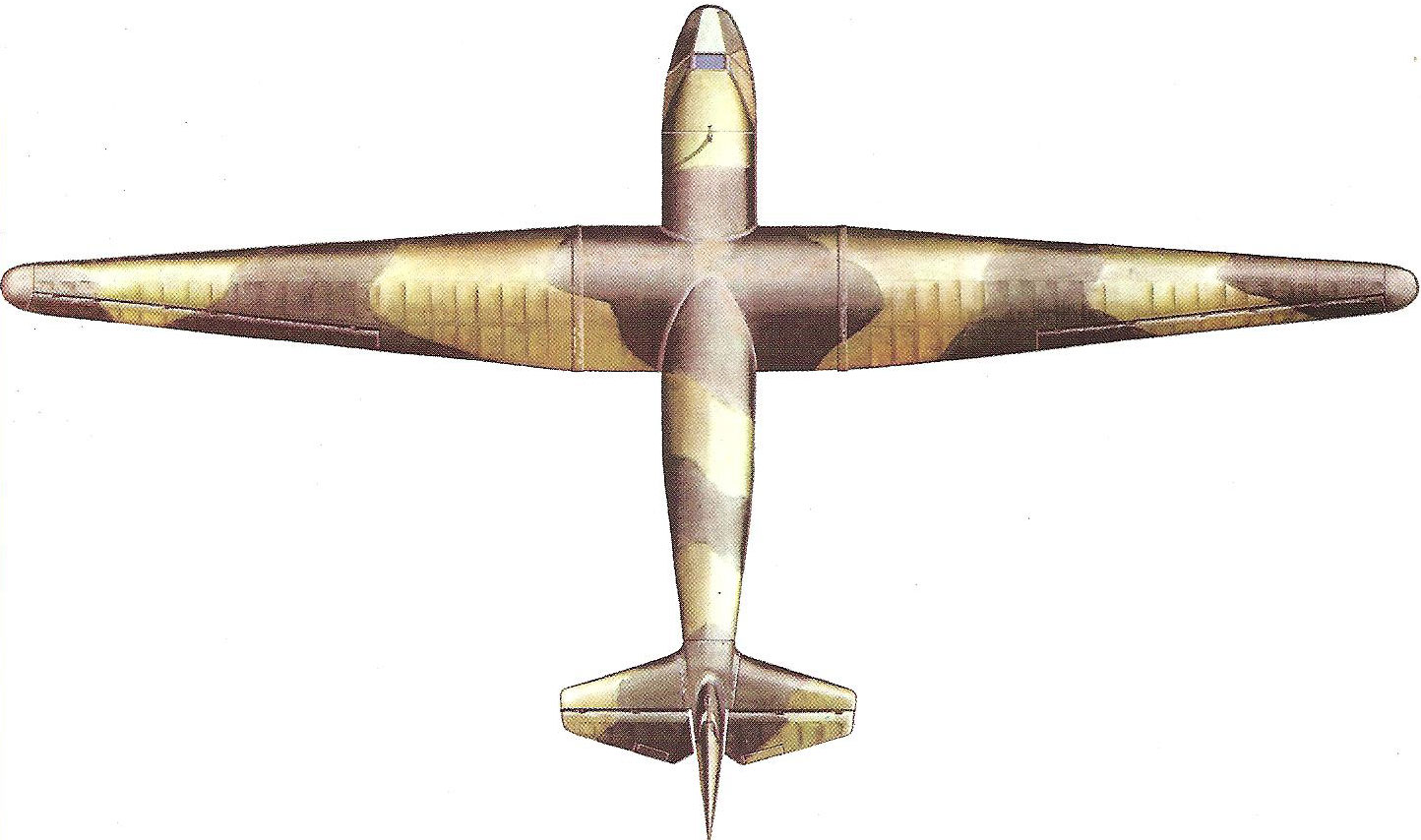
A-7
The Antonov A-7, also known as the Red-Front (Rot-Front)
RF-8, was one of the early Soviet military transport gliders. It won a design
award for Oleg K. Antonov, the famous aeronautical engineer. The first models
were built about the time World War II started (1939). In its high aspect-ratio,
its 62.2-foot wing, and its fuselage, it preserved many of the excellent flying
characteristics of a sailplane. It was 37.7 feet long and carried eight
equipped soldiers.
It had a retractable landing gear and all the latest
instruments necessary to enable the pilot to handle the glider in all flyable
weather; 400 were manufactured.
The Army used the A-7 extensively to support Soviet
guerrillas operating against the Germans. The glider was towed by the Il-4, the
SB-3 and the Il-2.
A-7 Technical Data
Crew: Pilot
Dimensions
Wingspan: 62.2′
Wing area: 335 square feet
Fuselage length: 37.7′
Weight
Cargo: 2,000 lb
Payload
Pilot, 8 equipped troops
Tow-planes: Li-2, SB-3


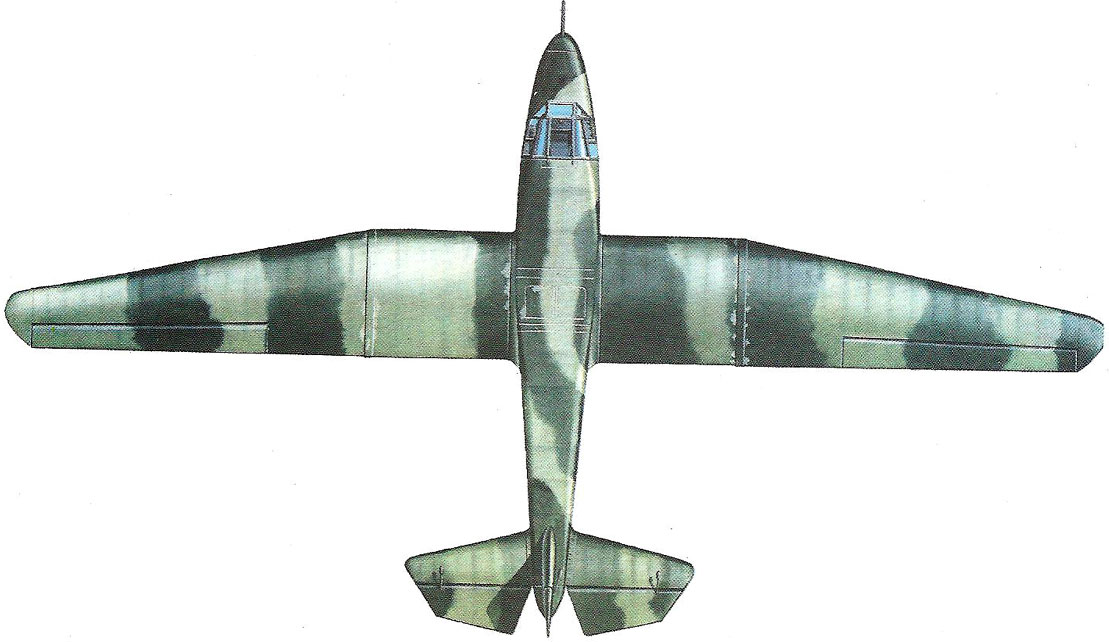
A-11 (G-11)
While some sources doubt that the A-11 was ever built, there
is substantial evidence to prove its existence. The evidence shows that the
A-11 was an improved version of the A-7 glider. It was similar in appearance to
the A-7, except for the fact that it had a strut-braced wing.
Vladimir Gribovskii collaborated with Oleg K. Antonov in its
design and development. It had a wing span of 82 feet and a length of 42 feet.
Reports also exist of a G-11 glider. In view of the fact
that Gribovskii was the co-designer of the A-11, it is possible that the A-11
and the G-11 (Gribovskii-11) were one and the same glider, the A-11 at some
time taking the G-11 designation for unknown reasons.
A-11/G-11 Technical Data
Type: Transport
Crew: Pilot and co-pilot
Payload:
Pilot, co-pilot, 20 equipped troops
Dimensions
Wingspan: 82′
Fuselage length: 42′
Weight
Cargo: 4,400 lb

BDP (S-1)
In July 1941, the Bureau of Special Construction, OK B
(Osoboe Konstruktorskoe Buro), ordered the production of a battle
transport-glider, BDP (Boevoi Desantnyi Planer). The first model was built
within a month, and the first test-flight was made before the end of the
summer.
The BDP (S-1), as it became, had a high cantilever wing 65.7
feet long, of wooden construction, with a high aspect ratio. It was tapered and
had a wing-root dihedral. Trailing edge flaps were fitted.
The monocoque fuselage was oval shaped and accommodated a
pilot and 20 fully-equipped troops. Gun-ports were built into the fuselage,
from which glidermen could shoot at attacking aircraft or, while landing, at
enemy troops. The wheel under-carriage was dropped after take-off and the
glider landed on plywood runners.
The government stopped production shortly after the first
gliders were manufactured, deploying the factory to the east in Russia to
escape destruction by the advancing Nazi armies. Production of the BDP (S-1)
was not resumed because the government turned all aircraft production resources
toward the construction of combat aircraft.
BDP (S-1) Technical Data
Type: Battle glider
Crew: Pilot
Payload: 20 soldiers, equipped, or equivalent weight in
other cargo.
Towing speed: 100 mph (maximum)
Dimensions
Wingspan: 65.7′
Wing area: 481 sq ft
Weight
Total with cargo: 7,700 lb
Empty: 5,070 lb
Cargo: 2,630 1b
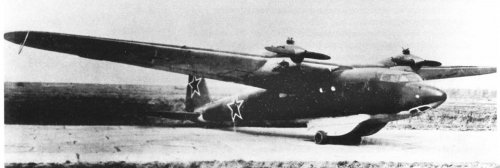
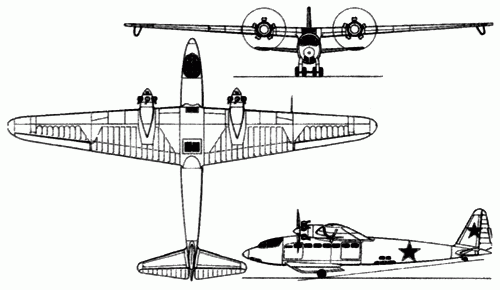
MOTOR-GLIDER MP-1
The motor-glider MP-1 (Motoplaner-1) showed the wartime
continuation of Russian hopes to develop a satisfactory powered glider—long a
dream of glider advocates. This development took place in 1943 just before the
deployment of the factory to the east. The MP and the BDP (S-1) differed only
in minor detail, except for the installation of two 140-hp five-cylinder
engines on the leading edge of the wing of a standard BDP (S-1). A fixed-wheel
landing gear was installed, also hoops at the ends of the wings to protect the
tips on landing. A trim tab was fitted to the rudder, and a small window at the
bottom of the nose to give the pilot better visibility.
The MP-1 had to be assisted at take-off when carrying a full
load, but when empty could take off without assistance. It was released by its
tow-plane once airborne and flew at 100 miles per hour, having a range of close
to 500 miles.
GLIDER-BOMBER PB
During 1942, the OKB considered building a single-seat
glider bomber, the PB (Planer Bombardirovshchik) and produced plans for it.
These called for the glider to have an internal bomb bay that would allow for a
variety of loads, including supply containers and a 4,400 lb bomb. The project
was dropped, however, perhaps because of the urgent need for facilities and
materials to build combat aircraft.
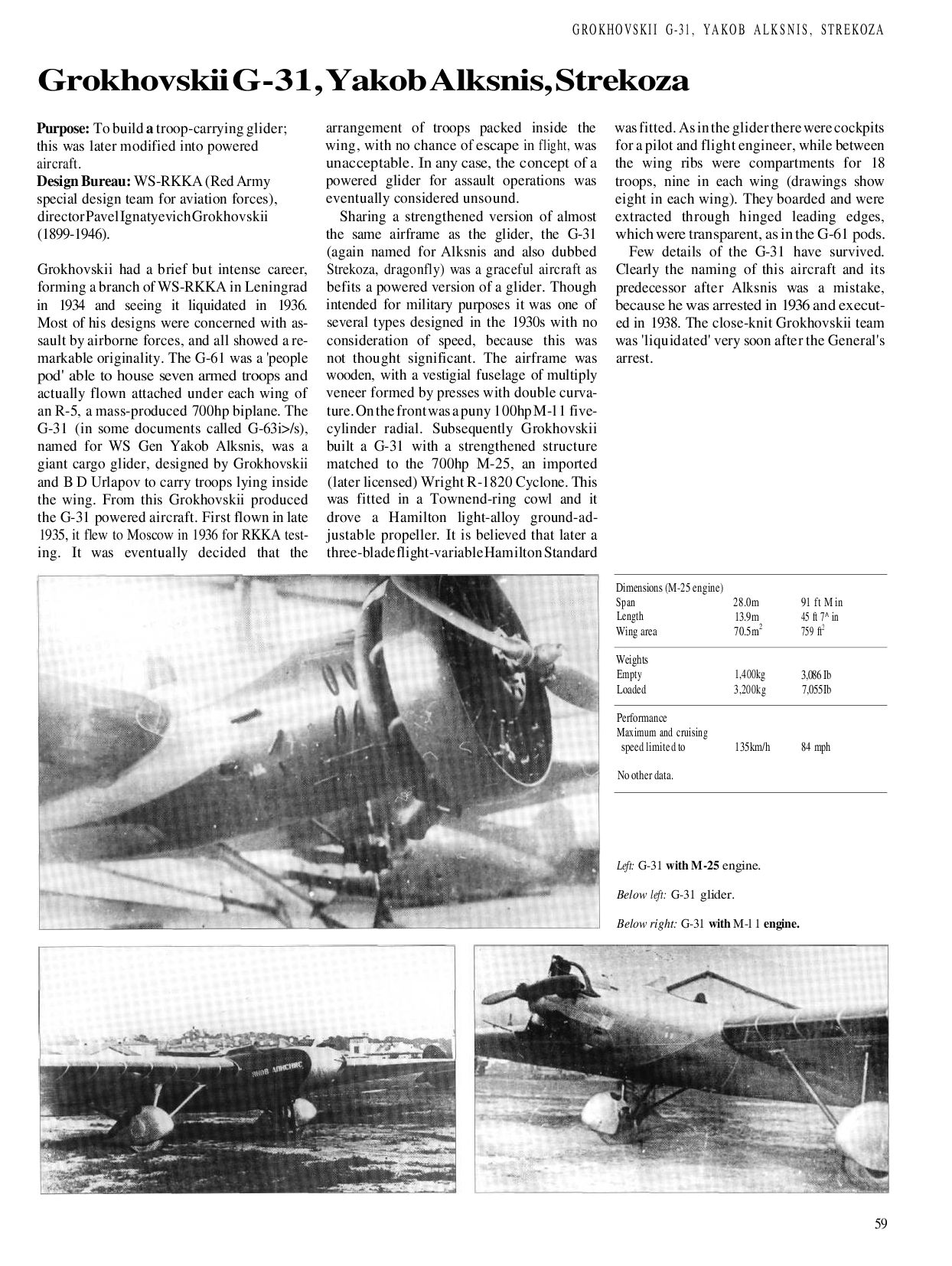
G-31
The G-31 military glider was a daring experiment far ahead
of its time. It was designed by Pavel Ignat’evich Grokhovskii, military pilot,
parachutist, inventor, and head of the special design bureau of the Leningrad
Institute.
It was a mid-wing all-wooden monoplane. The fuselage was a
narrow plywood monocoque construction that used wood-fabrication techniques
advanced for that day. The pilot and co-pilot sat above the wing in a
plexiglass enclosure. The forward edge of the wing, which was 91.9 feet long,
was transparent for approximately sixteen feet on each side of the fuselage.
Eighteen passengers, nine on each side, lay flat in the wing behind the
transparent window.
The G-31 glider-plane or powered glider, Yakov Alksnis,
followed the development of the G-31 glider. A 700-hp M-25 9-cylinder radial
engine, placed in the nose, powered the Yakov Alksnis.
After flight tests of these gliders had been conducted at
Moscow, it became clear that the design did not allow for quick enough
abandonment of the glider by its passengers in an emergency or when landing
under fire in combat. For this reason, the G-31 and G-31 Yakov Alksnis were
abandoned.
G-31 Technical Data
Type: Transport glider
Crew: Pilot and co-pilot
Dimensions
Wingspan: 91.9′
Wing area: 753 sq ft
Weight
Total with cargo: 7,054 lb
Empty: 3,086 lb
Cargo: 3,968 lb
Payload
18 troops fully-equipped.
Flight performance
Maximum airspeed: 84 mph
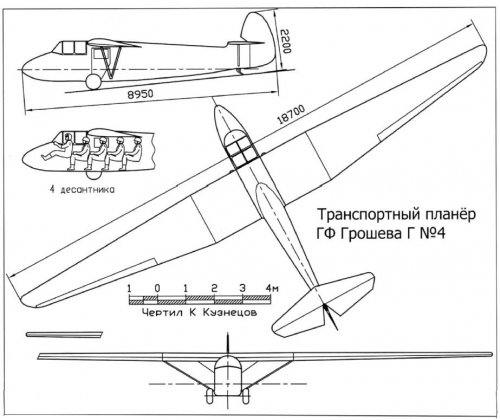
GN-4
The GN-4 (Croshev No. 4), designed by G. F. Groshev, was
built at the Moscow Glider Factory shortly after the factory’s establishment.
It was first revealed to the public in the 1934 all-union glider meeting.
This was the world’s first transport glider. In design, it
stood between the sailplane and the wartime transport glider, although in
configuration it was much like a large sailplane. Although designed to be towed
throughout its flight, except for the few minutes after its release from its
tow-plane, it is reputed to have flown as a sailplane under suitable wind
conditions. It was primarily designed for flying as one of a combination of
gliders in a glider train, and was normally towed by the commercial version of
the R-5.
The GN-4 was a strut-braced high-wing monoplane with a
narrow oval fuselage. It had an enclosed pilot’s compartment with five
passenger seats behind the pilot. The 60-foot wing had a straight leading edge
and a trailing edge tapered from the centre section. It had a very high aspect
ratio. The R-5 towed it at close to 100 miles per hour. The empty weight of the
glider was 1,000 pounds.
GN-4 Technical Data
Type: Transport glider
Crew: Pilot
Dimensions
Wingspan: 60′
Fuselage length: 27′
Weight
Total with cargo: 1,992 lb
Empty: 1,000 lb
Cargo: 992 lb
Payload
5 passengers
Flight performance
Towing speed: 100 mph
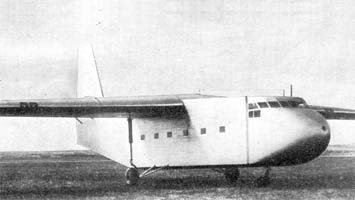
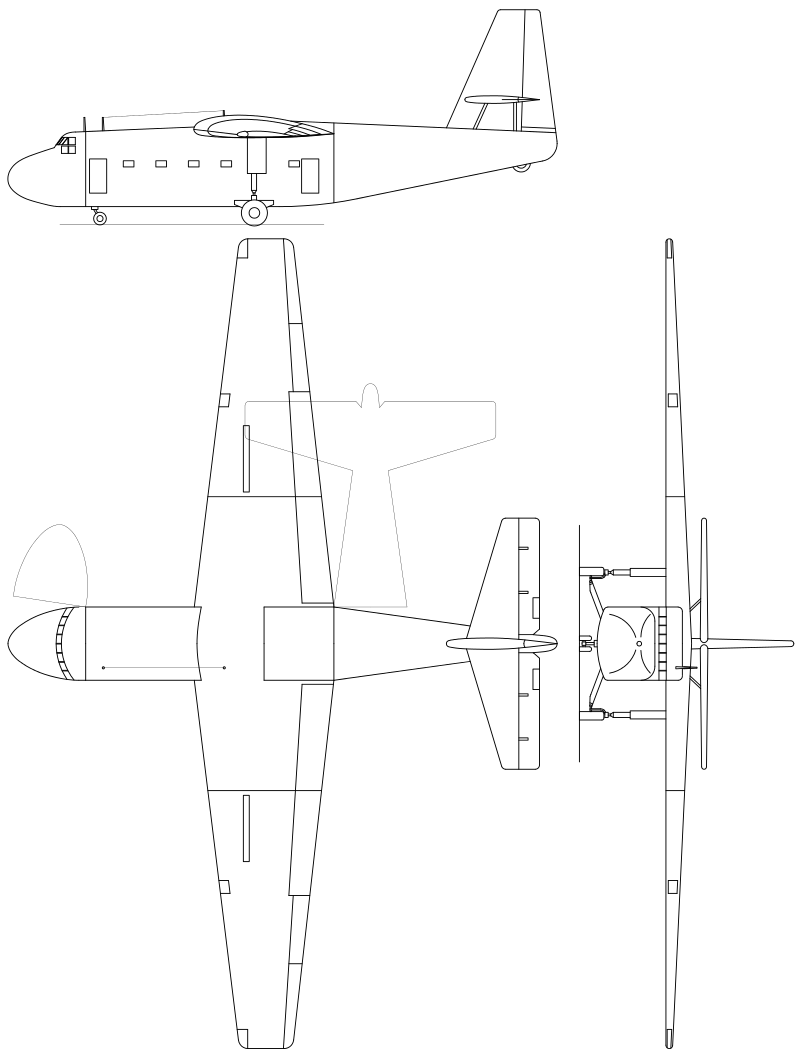
Il-32
The Il-32 was designed by S. V. Ilyushin and a single
glider, a prototype, was finished in 1948. No others were built.
It was an all-metal, high-wing, cantilever monoplane. A
unique feature was that both the nose and the rear of the cargo compartment
were hinged to permit the loading of heavy or bulky equipment. The glider had
built-in ramps for loading wheeled cargo.
It carried a crew and thirty-five fully equipped soldiers.

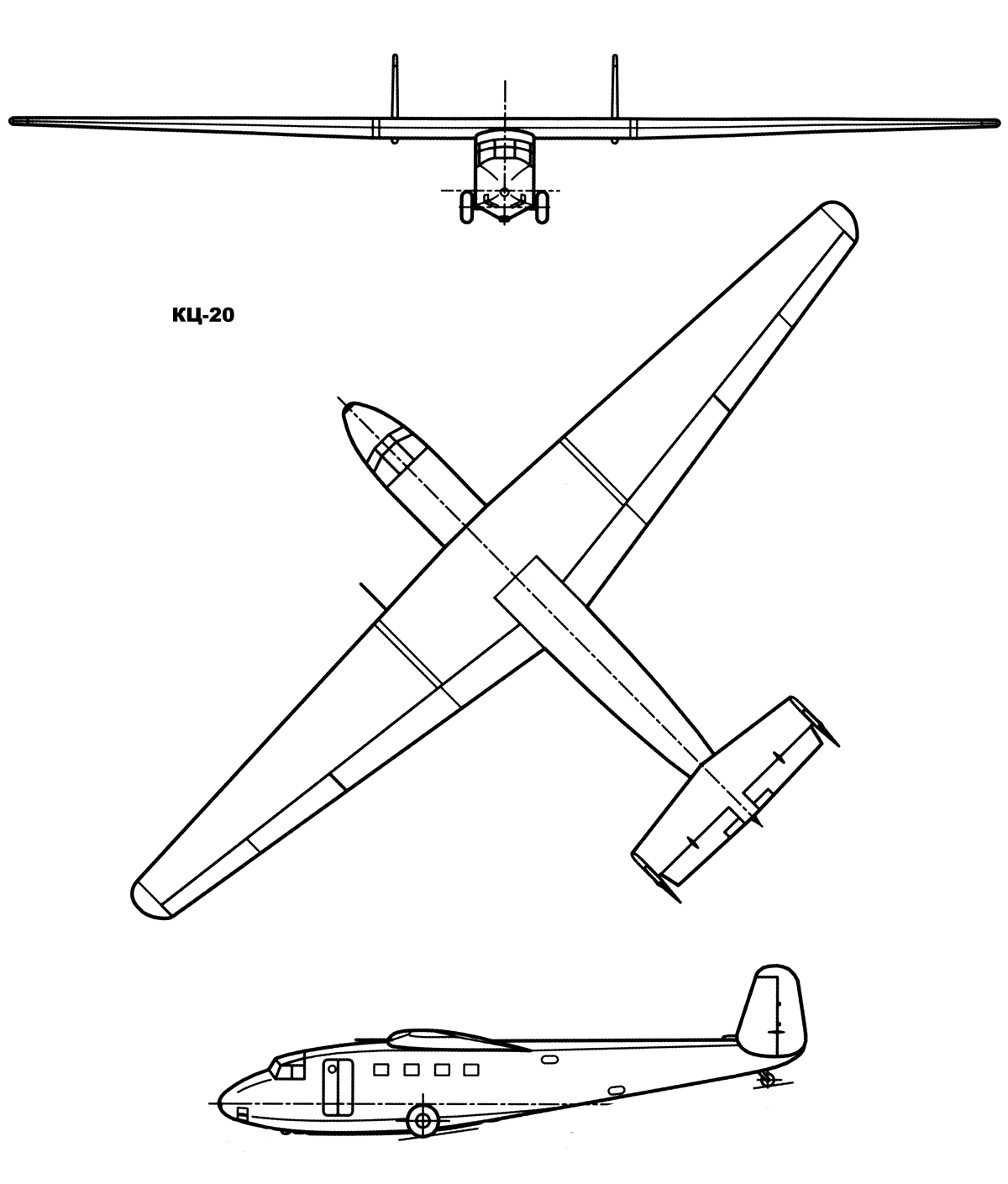
KT-20
Conceived in 1944 by D. I. N. Kolesnikov and P. V. Tsybin,
well-known in the Soviet Union as pioneers in glider design, the KT-20 (named
after the designers) was a large transport glider. A few were built in the
Yakovlov factory. It had a sharply tapered strut-braced wing 72.6 feet long and
a tapered fuselage 49.4 feet long.
The KT-20 was loaded from the rear. The section beyond the
trailing edge of the wing lifted upward to open the cargo compartment. It was
constructed of wood and metal and carried twenty-four troops or 4,410 pounds of
cargo. It was towed by the Il-12.
KT-20 Technical Data
Type: Transport glider
Crew: Pilot and co-pilot
Dimensions
Wingspan: 72.6′
Fuselage length: 49′
Weight
Cargo: 4,410 lb
Tow-plane: Il-12
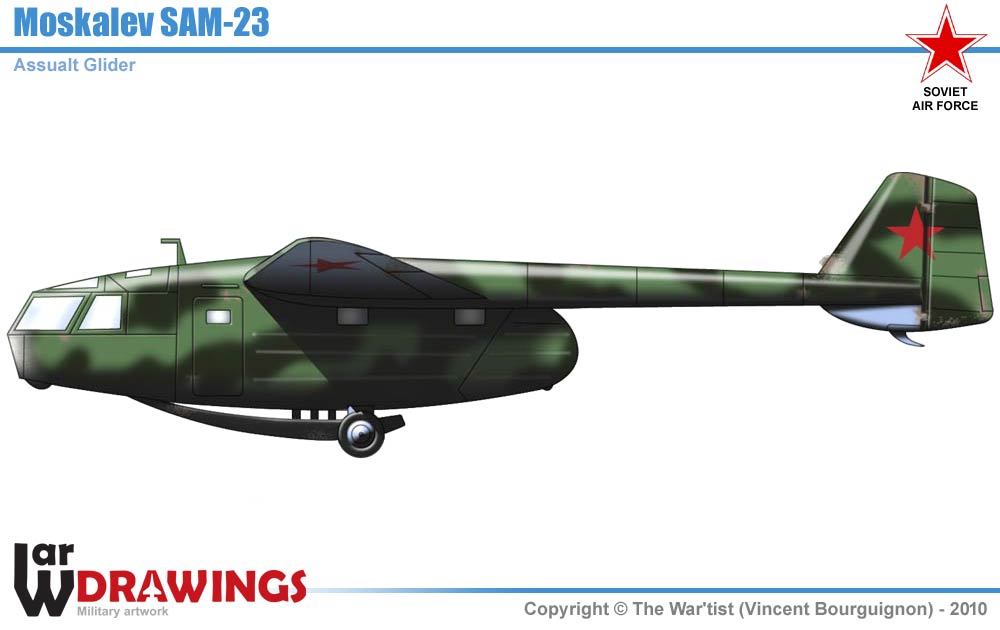
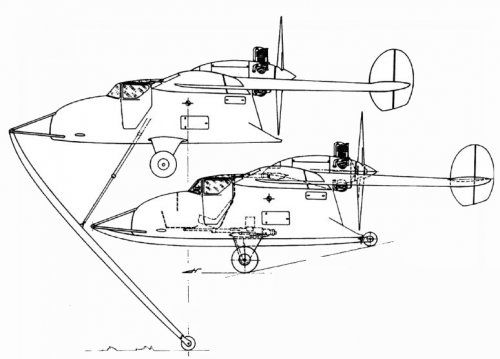
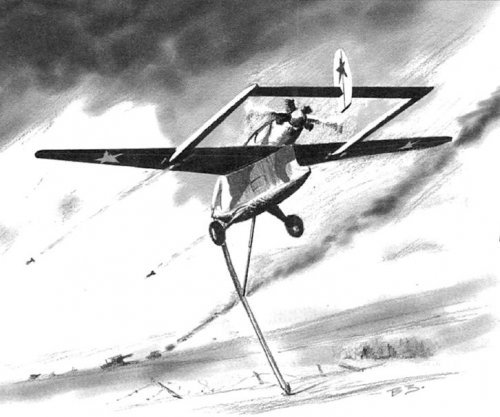
SAM-23
In 1943, in addition to the KT-20 and the BDP (S-1), the
Soviets produced the SAM-23. It was a high-wing, twin-boom, sturdily built
monoplane resembling the U.S. YCG-10A. A. S. Moskalev, its designer, conceived
a “gondola” fuselage, and so designed the SAM that it efficiently loaded and
carried bulky cargo, including Jeep-sized vehicles. The pilot and co-pilot sat
in the nose behind a large concave plexiglass window which allowed excellent
observation.
The glider had an integral ramp that was lowered when the
rear of the cargo compartment was raised, and was propped up between the booms
for loading. It could carry sixteen men or a jeep, or an equivalent weight in
other cargo.
The Soviets produced a number of SAM-23’s. Moskalev also
proposed a motorized SAM, but the project never developed beyond the design
stage.
SAM-23 Technical Data
Type: Battle transport glider
Crew: Pilot and co-pilot
Weight
Cargo: 3,600 lb
Payload:
16 equipped troops or a jeep or the equivalent of other
cargo.
JAKOVLEVA-CYBINA GLIDER
This glider was reportedly shown at the Moscow Soviet
Aviation Day exhibitions in 1949. Six were designed and built under the
direction of A. S. Jakovleva, and another six under the direction of
aeronautical engineer P. V. Cybina.
It is possibly the same craft as the medium-sized Tshibin
cargo glider, since the likelihood of two new gliders appearing at this date is
questionable. On the other hand, descriptions of the Jakovleva-Cybina—and the
fact that there appears to be no question that one glider was designed and
built by these two engineers and the other by Tshibin (in his own right a
prominent aircraft designer)—lead to the conclusion that there were, in fact,
two new and different models. It is interesting that descriptions of the
Jakovleva-Cybina glider and the American World War II CG-4 are similar; and it
is quite evident that the Jakovleva-Cybina and the CG-4 are alike in
appearance.
The Jakovleva-Cybina glider had a large “greenhouse,” giving
the pilot and co-pilot excellent visibility relatively free from interference
from structural bracing. It carried troops or cargo, and could be used for
parachute drops. It was fabric covered and opened from the front for loading.
The towing aircraft was the Il-12.
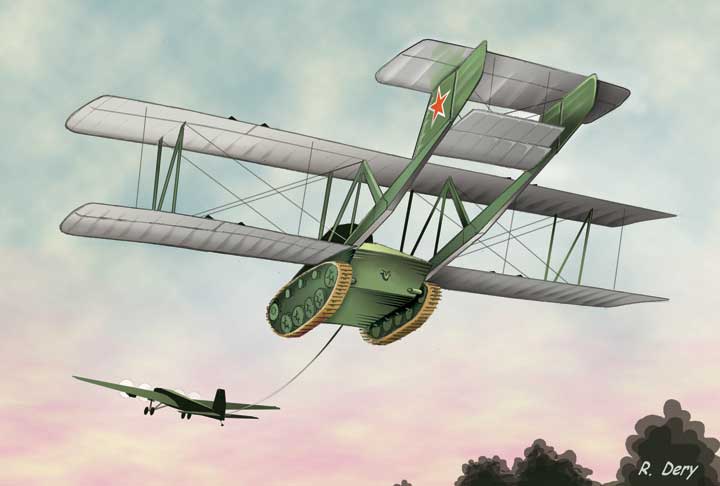
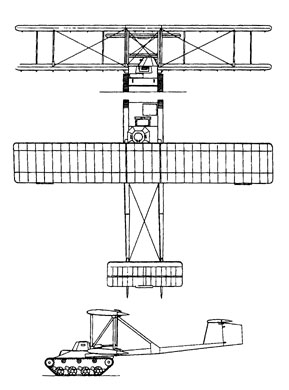
WINGED TANK “KT”
Around 1941, it was rumored in Soviet circles that the
Soviet Army was in the process of developing a glider transport system that
could carry a small battle-tank. More recently available reports about this
project tend to confirm the fact that such a project did exist.
Assisted by a staff of engineers, Oleg K. Antonov was
charged with the development and construction of what came to be known as the
transport glider KT (Kryliatyi Tank or Winged Tank). The project apparently
started in 1939 or 1940 and was completed in 1941, when the system was tested.
The KT was a new departure in transport glider design in
several major respects. One very interesting feature is that it was a biplane
glider. Second, Antonov used the T-60 tank as the fuselage of the glider; this
combination could be towed into the air and released while in flight to glide
down to a pre-selected spot behind enemy lines. The six-ton T-60 tank, its gun
pointing to the rear, was secured between the twin booms of the glider and
attached to the under surface of the lower wing. A substantial part of the tank
protruded ahead of the lead edge of the lower wing. The system was so designed
that the controls for the glider were inside the tank.
In view of the shortage of metal in the Soviet Union at the
time, the glider frame was made of wood, and the wings and empennage were
covered with fabric.
With the test pilot Sergei Anokin at the controls of the
winged tank, Pasha Jeremejew, at the controls of a four-engined TB-3 bomber,
towed the enormous weight into the air. Although the take-off and early stages
of the flight went well, the bomber’s engines began to overheat, and the glider
had to be released. Anokin started the tank’s engine and then let the tank
treads start to move slowly. At about 200 feet above the ground, he accelerated
the treads; they reached their maximum land speed just before the treads
touched the ground. The system landed smoothly, and Anokin brought it to a
stop. The tank was quickly disengaged from its wings, and it raced off.
Despite the success of the first flight, no others took
place, reportedly because there was a shortage of towing aircraft with enough
power to tow the winged tank, such planes then being urgently needed at the
front.
KT Technical Data
Type: Battle-tank transport glider
Crew: Pilot
Weight
Empty: 4,800 lb
Cargo: 13,200 lb
Total with cargo: 18,000 lb
Dimensions
Wingspan: 49.2′
Wing area: 732 sq ft
Fuselage length: 37.7′
Payload: 1 six-ton T-60 tank
Flight performance
Lift off speed: 100 mph
Tow-plane: TB-3 bomber
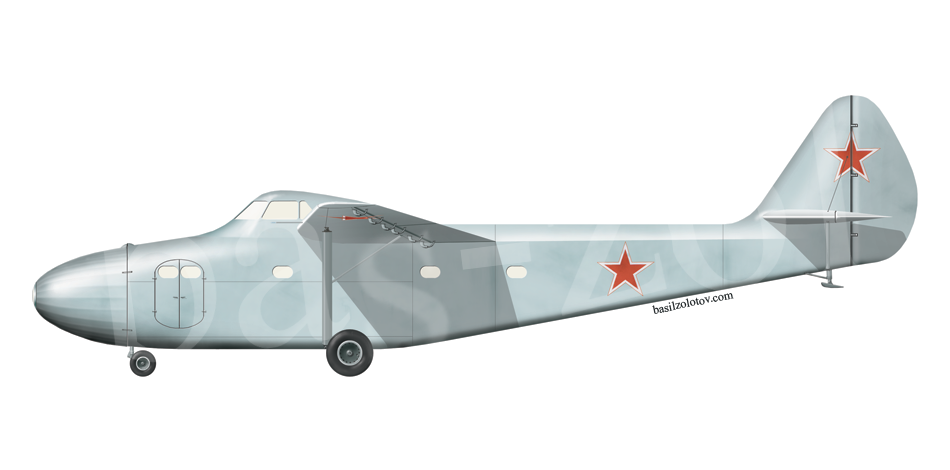
TS-25
First seen by the public in 1948 at the Soviet Aviation Day
exhibition in Moscow, the TS-25 was one of the largest of the postwar Soviet
gliders to go into production. At the time of the exhibition, six had been
manufactured. It had many of the design characteristics of the wartime KT-20,
for which Tsybin was a co-designer, and in one way can be considered a
technologically sophisticated successor to the KT-20.
Designed by P. V. Tsybin, the TS-25 was a heavy
cargo-glider. It had a braced high wing and a pilot’s compartment sitting above
the cargo compartment. The nose was hinged to facilitate loading. The wheels
could be dropped, after which the pilot landed the glider on skids fitted to
the bottom of the craft. The glider appeared to be constructed largely of wood,
with wing and fuselage exteriors of stressed plywood.
The Soviets furnished a number of the TS-25’s to the
Czechoslovak military forces, who called it the NK-25.
TS-25 Technical Data
Crew: Pilot and co-pilot
Weight
Empty: 5,115 lb
Cargo: 4,806 lb
Total with cargo: 9,921 lb
Dimensions
Wingspan: 82.8′
Wing area: 830 sq ft
Fuselage length: 54.1′
Payload: 25 troops, equipped, small vehicles, light
artillery, or miscellaneous cargo.
Towing speed: 155 mph (maximum)
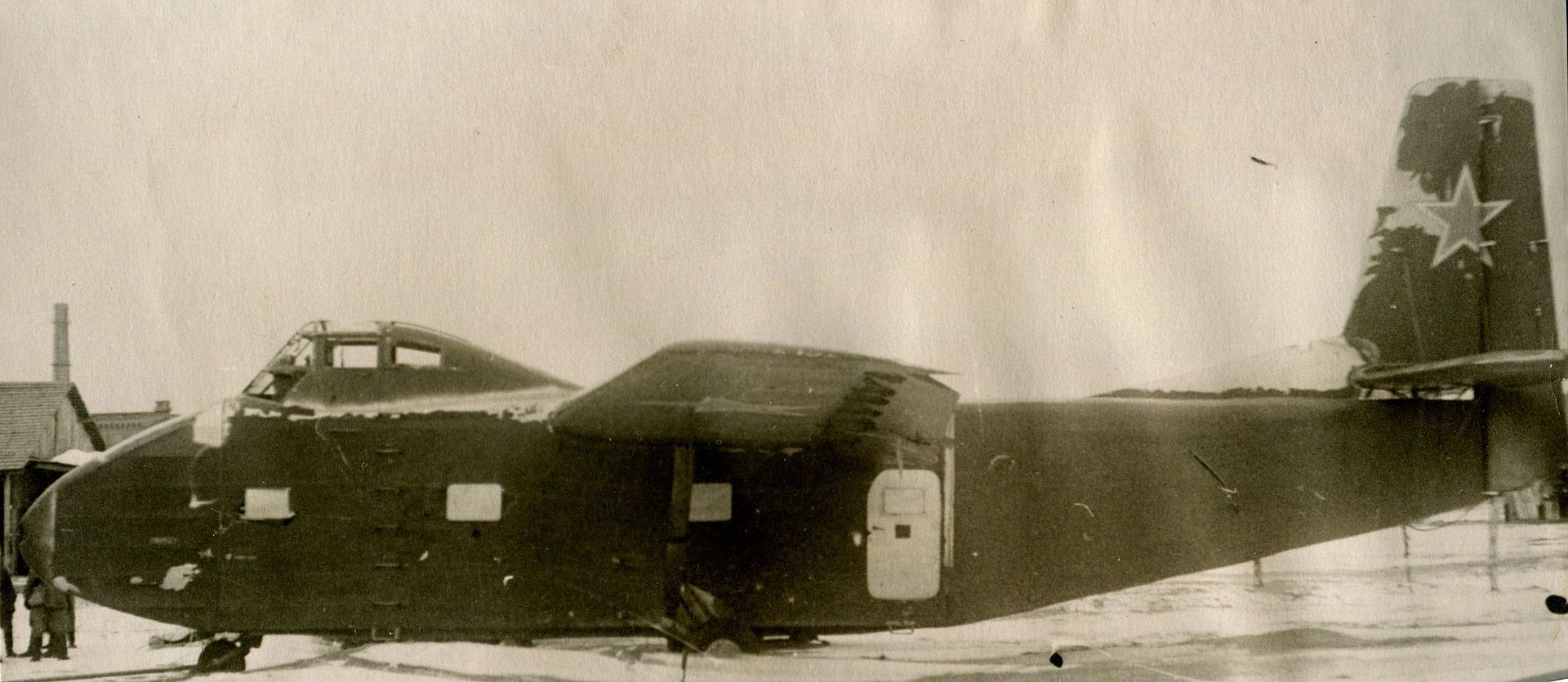
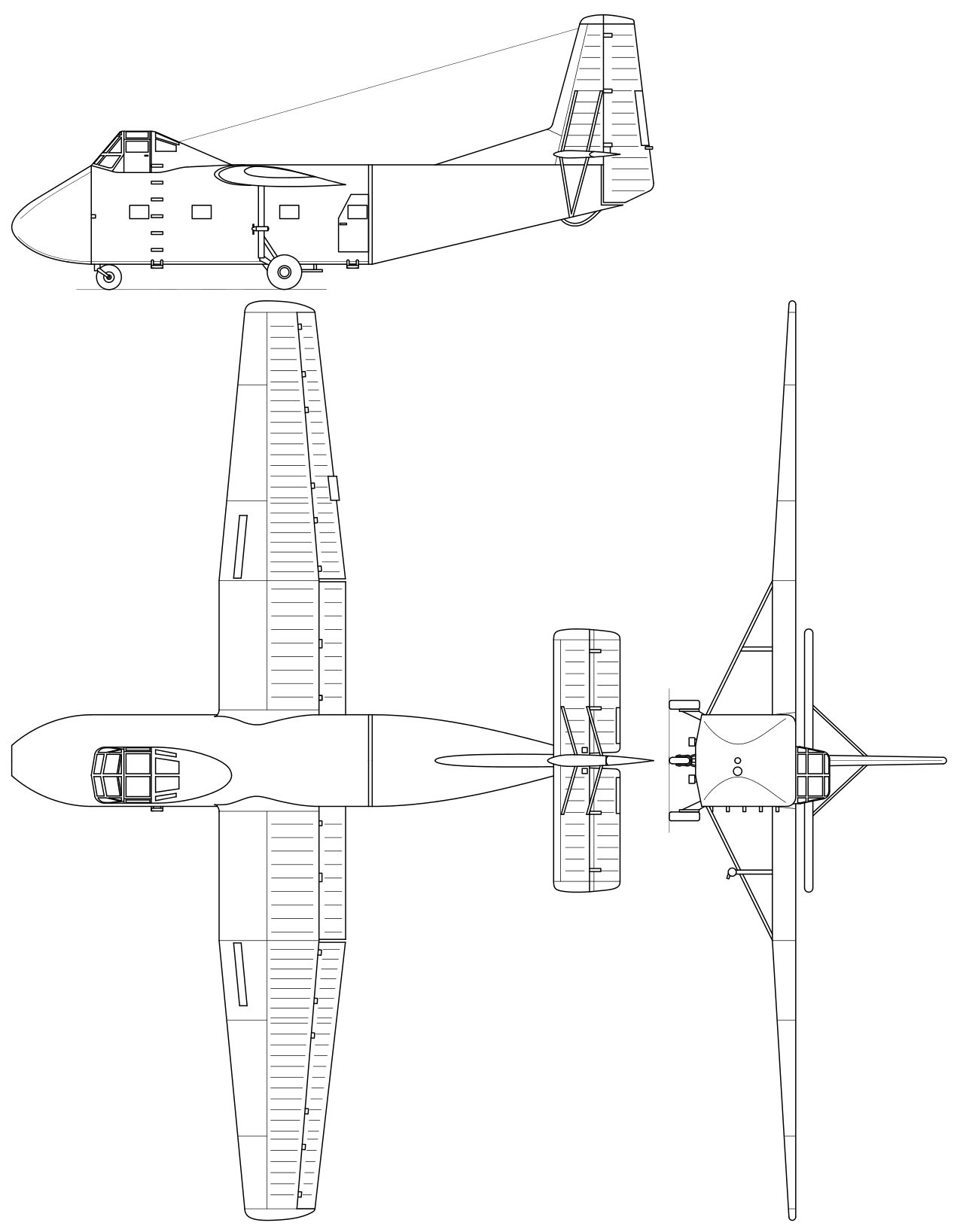
Yak-14
The Yak-14, a large, bulky, square-shaped wooden glider was
designed by A. S. Yakovlev and produced shortly after the war. This glider and
the TS-25 caused a sensation at the Soviet Aviation Day Show held at the
Tushino Airport near Moscow in 1949, when six of each flew overhead in what was
described as “spectacular glider-trains.”
The Yak-14 had a high-aspect-ratio braced wing with a span
of 85.8 feet. The wing was built from three sections, a rectangular center
section and two tapered outer sections that were square at the ends. The wing
had no dihedral. Fowler flaps and slotted ailerons extended over the whole of
the trailing edge.
The nose opened sideways to permit the loading of cargo. The
pilot and co-pilot sat in the nose, which featured a large “greenhouse”, giving
the pilot excellent visibility relatively unobstructed by structural bracing.
The Yak-14 carried small vehicles or other cargo to the
extent of 7,716 lb, or could transport thirty-five fully-equipped soldiers, and
it could be used to drop parachutists. The cargo compartment measured 26.3 feet
in length by 7.6 feet in height and was 7.4 feet wide. The maximum towing speed
was 186 miles per hour.
The Soviet Union supplied several of these gliders to the
Czechoslovak military forces.
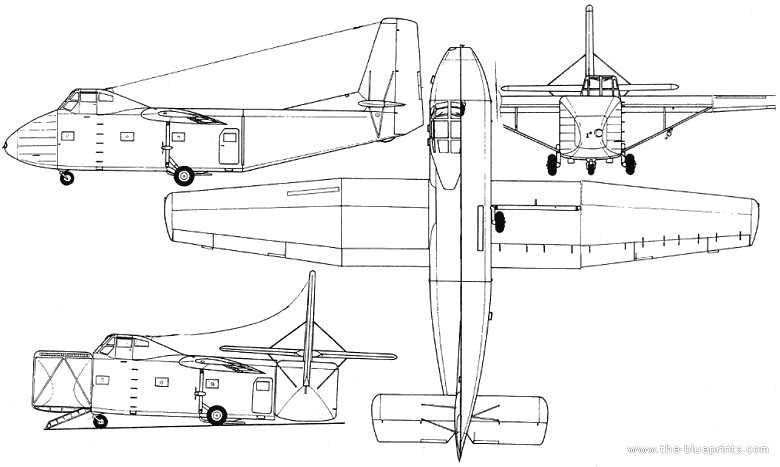
Yak-14 Technical Data
Type: Transport glider
Crew: Pilot and co-pilot
Weight
Empty: 6,825 lb
Cargo: 8,056 lb
Total with cargo: 14,881 lb
Dimensions
Wingspan: 85.8′
Wing area: 1,050 sq ft
Fuselage length: 60.5′
Cargo compartment
Length: 2 6.3′
Width: 7 .4′
Height: 7 .6′
Payload: 35 fully-equipped troops
Towing speed: 186 mph (maximum)